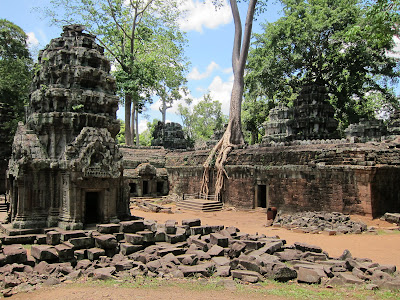Yes. We know. Some of you want to see pictures of people in this blog and not only monuments. But if there is a place which deserves an article to its magnificence – for sure – it is ANGKOR!
In fact, due to the archeological park dimensions, we had to rent a tuk tuk and its driver for three entire days and spent an average of eight hours per day sightseeing!
What remains of the ancient capital of the Khmer powerful empire are the religious temples. Habitations were made of perishable materials and did not last until our modern days. Khmers ruled most of Southeast Asia from the end of the 8th century until the beginning of the 14th century. Each king had to build a temple to honor his predecessor. Also, different Khmer rulers wanted their own state temple. So the centre of the city was displaced a few kilometres further. That explains the dimension of the actual sight: most of the temples are concentrated in an area of 24 kilometres east to west and 8 kilometres north to south – like the two most important : Angkor Wat and the complex of Angkor Thom - but some sites are located 48 kilometres away!
The biggest religious monument in the world, Angkor Wat, 8,5 hectares (St Peter's Basilca in Rome, 3,3 ha)
Bayon in Angkor Thom with its enigmatic faces
With a population that reached 3 million people, Khmers knew the importance of water for their prosperity and built several massive water reservoirs. The largest one, West Baray, is covering an area of 1,760 hectares with an average depth of 7 metres, for a capacity of over 123 million litres and is still in use today!
Among the famous builder kings, Jayavarman VII is still a national icon and gives his name to hospitals, etc. He is the first one who adopted Buddhism as official religion whereas his predecessors and immediate sucessors were pious Hindus. Under his reign was launched the most important construction and renovation program ever seen.
Buddha in Angkor Thom
Dancing apsaras on the Bayon, Angkor Thom
Except for some low relief and Buddha statues, the interior of the temples are pretty empty. It is the structure and the external decoration of the temples which deserve attention.
Pre Rup
Banteav Srei, famous for its decorated carvings in sandstone
The most stricking feature of Angkor is the symbiosis with nature. During many centuries, the temples were abandonned to the elements. Mother Nature regained her duties. And with the helpful tropical climate, a dense forest soon covered the temples. Still nowadays trees are emerging from the temples. A bit like the story of the egg and the chicken, it is difficult to imagine which one came first..
Views of Ta Prohm. Where is Luis?? ;)
This gives to some temples a romantic athmosphere and to us some sensations of adventure. We felt like Indiana Jones, climbing some rocks to enter temples almost collapsed.
Beng Melea
Beng Melea
Banteay Kdei
Outside Angkor park, in the Kulen Hills, climbing one and half kilometres to reach the "River of a Thousand Lingas" is fully worth the effort. In the middle of the forest, on a 150 metres stretch, one can see Hindu divinities sculpted in the river bed. The fields of lingas (representation of the Hindu deity Shiva) are indeed striking. And we felt a kind of magic walking through this tropical forest where the roots of the trees are visible and some lianas got tangled in suspension.
















Very beautiful, but we still want more pictures of people!
ReplyDeleteOlga
Axelle, t'as complétement maigri !
ReplyDelete